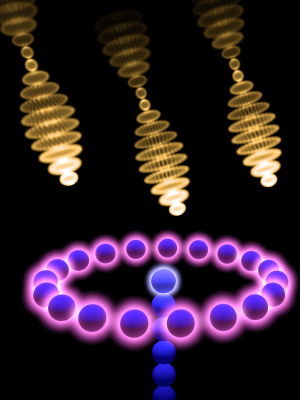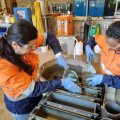
An international team of theoretical quantum physicists is working on a way of absorbing light and storing it as energy.
The University of Queensland’s School of Mathematics and Physics’ Dr Tom Stace said the research could revolutionise solar electricity generation and storage, and create a new generation of cameras and optic-fibre based communications.
“In the dark or in bright light, a camera using this technology would see better than the human eye, and produce super-high resolution pixels,” said Dr Stace, who is collaborating on the research through the ARC Centre for Engineered Quantum Systems.
Nature Communications published the team’s findings, reporting that the technology would harness a phenomenon known as “superradiance”.
Dr Stace said supperradiance occurred when atoms interacted with the surrounding electromagnetic field, absorbing and emitting light at high speed.
“Collectively, the atoms release a far more intense light pulse than they can individually,” Dr Stace said.
He said the research addressed a fundamental scientific problem of how to optimise energy absorption before the atoms released it back as light.
“The ability to harnessing light at an atomic level would improve solar panels, and bring scientists a step closer to building a ‘super-absorber’ for energy storage,” Dr Stace said.
The researchers were intrigued by the process algae used to transform light into electrochemical energy.
Dr Stace said they questioned conventional thinking about the ability of nanostructures to rapidly absorb energy, and how to prevent it being reemitted just as quickly.
“We began by asking how light absorption might be increased if an algae’s chloroplasts – specialised sections of plant and algal cells – could be reengineered,” he said.
“Our theoretical model shows that superabsorption, the reciprocal process of superradiance, can be achieved and sustained in certain simple nanostructures by engineering how the atoms interact with one another.
“By combining the well-established physical phenomena of superradiance, light filtering, photonic band gaps and quantum feedback control, we demonstrated that it is possible to sustain super-linear scaling of the light absorption rate.”
The Nature Communications paper, Superabsorption of Light via Quantum Engineering, explains how interactions between the atoms, in a suitable geometrical arrangement, might allow a quantum system to be controlled such that a sustained superabsorbing state can exist.
To prove this principle, the Dr Stace and the other researchers proposed a particular array of quantum dots, noting that its molecular ring structure was similar to the photosynthetic light harvesting complex found in algae.
“Our design might become the basis of highly efficient systems for harnessing solar energy in the future,” Dr Stace said.
“But in the meantime, what we’ve discovered about superradiance could help build an ultra-sensitive light sensor for the world’s most powerful camera.”
The research group includes UQ’s Professor Gerard Milburn, Professor Simon Benjamin and PhD student Kieran Higgins from the University of Oxford, Dr Brendon Lovett from St Andrews University and Dr Erik Gauger from the National University of Singapore.
Contact: Dr Tom Stace, 07 3346 9398 or 0404 413069, stace@physics.uq.edu.au
.jpg)










